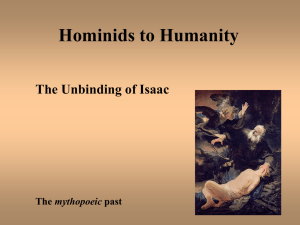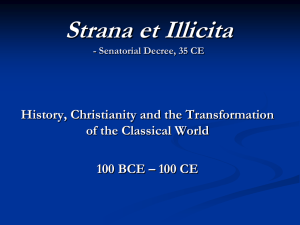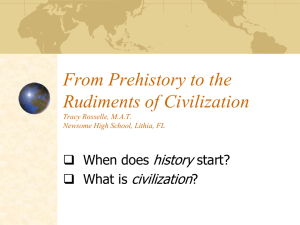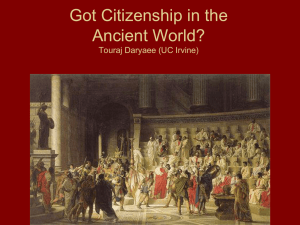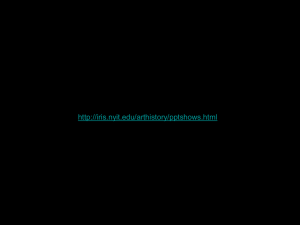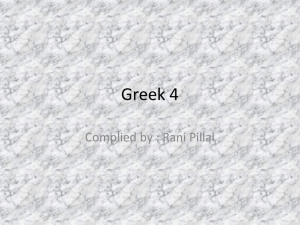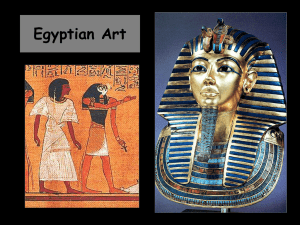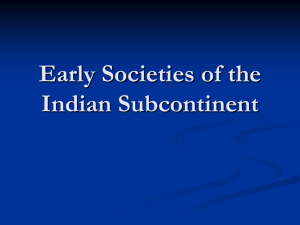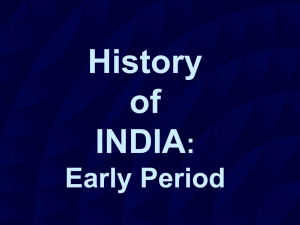4W ppt: Islamic Empire - University of Southern California
advertisement
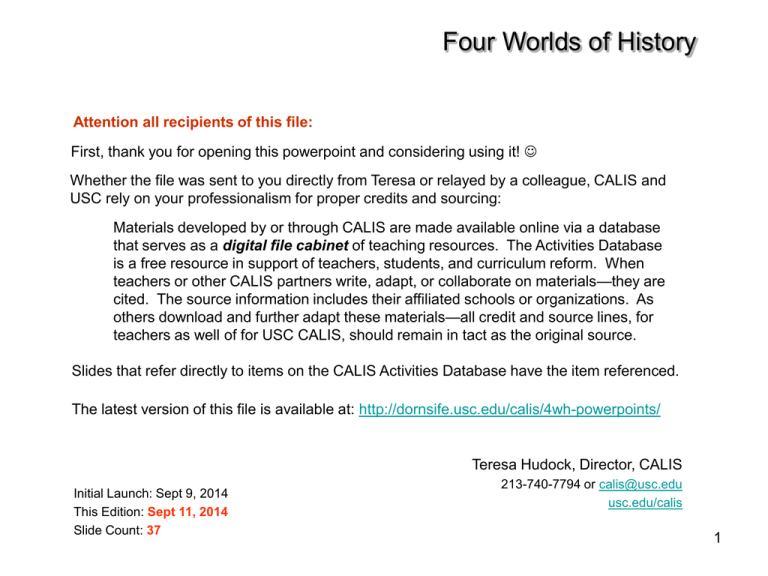
Four Worlds of History Attention all recipients of this file: First, thank you for opening this powerpoint and considering using it! Whether the file was sent to you directly from Teresa or relayed by a colleague, CALIS and USC rely on your professionalism for proper credits and sourcing: Materials developed by or through CALIS are made available online via a database that serves as a digital file cabinet of teaching resources. The Activities Database is a free resource in support of teachers, students, and curriculum reform. When teachers or other CALIS partners write, adapt, or collaborate on materials—they are cited. The source information includes their affiliated schools or organizations. As others download and further adapt these materials—all credit and source lines, for teachers as well of for USC CALIS, should remain in tact as the original source. Slides that refer directly to items on the CALIS Activities Database have the item referenced. The latest version of this file is available at: http://dornsife.usc.edu/calis/4wh-powerpoints/ Teresa Hudock, Director, CALIS Initial Launch: Sept 9, 2014 This Edition: Sept 11, 2014 Slide Count: 37 213-740-7794 or calis@usc.edu usc.edu/calis 1 Four Worlds of History Medieval & Early Modern World History 7th grade Table of Contents Main Items & Issues 3 – Social Science Factors – clarifying the purpose & priorities of the 4W model 7 – Content Standard 7.2 – Civilizations in the Middle Ages: Islam 9 – Focus Question // Establishing Relevance – Governance, Identity and Religion 11 – 4W of Peaceful Transfer of Power 13 – Religious Demographics – Major Religions & Religious Sects 15 – Timeline: Birth of Five Major World Religions 27 – Identity: Who is Ibn Battuta? Who are You? 33 – Arab Spring 35 – Inference Exercise (Quote Activity) – Active Reading to Organize/Analyze Info 2 Four Worlds of History Social Science Factors basic factors of the human condition that are important to recognize …regardless of how they are described AND that are important to recognize …when they are missing 3 Four Worlds of History Social Science Factors Identifying factors, relating factors, and determining the “most important" factors social sciences sciences . is the the science science of the social 4 Four Worlds of History Social Science Factors The absolute PRIORITY of the 4W model purposeful meaningful relevant critical elements of being student-centered 5 Four Worlds of History Social Science Factors The absolute PURPOSE of the 4W model student-driven analysis toward independent critical thinking critical elements of being student-centered 6 California HSS Content Standards Political World Economic World economic 7.2 Students analyze the geographic geographic, political political, economic, social structures structures of the civilizations of religious, and social religious Islam in the Middle Ages. 4. Discuss the expansion of Muslim rule through military conquests and treaties, emphasizing the cultural blending within Muslim civilization and the spread and acceptance of Islam and the Arabic language. Social World Cultural World Focus Question? Writing Prompt? How did the Islamic Empire expand? What factors were most important? Focus Factors: • identity • belief systems • demographics Relevance? What are the connections? Past Present Personal 7 Political World Economic World Identify & Relate Factors Information Management Analysis & Critical Thinking Social World the science of the social sciences Cultural World 8 Organize information then infer and relate factors Political World Economic World How did the Islamic Empire expand? What factors were most important? The Expansion of Muslim Rule Social World Build on What You Know You might have seen on the television news that when a leader dies or resigns, a power struggle follows to determine his or her successor. After Muhammad died, several groups fought for control of the Muslim world. In 661, the Umayyad family won this power struggle. The Umayyads built a great empire with Damascus (located in present-day Syria) as its capital. Source: World History: Medieval and Early Modern Times, McDougal Littell, 2006, pages 113 –115. Chapter 4: The Rise of Muslim States, Lesson 1: The Expansion of Muslim Rule Cultural World 9 RELEVANCE Political World Economic World The Expansion of Muslim Rule Build on What You Know You might have seen on the television news that when a leader dies or resigns, a power struggle follows to determine his or her successor. After Muhammad died, several groups fought for control of the Muslim world. In 661, the Umayyad family won this power struggle. The Umayyads built a great empire with Damascus (located in present-day Syria Syria) as its capital. Social World Cultural World Who has heard about power struggles in the news? What types of governments have a peaceful transfer of power? What is sectarian conflict? What has been happening in Syria in the last 3½ years? 10 What types of governments have a peaceful transfer of power? Political World Economic World Governments based on… rule of law constitution If the transfer of power is not clear, then Social World what are the likely outcomes? power struggle coup assassination civil war vulnerability to attack possibly a complete takeover, conquest decline and suffering possibly a complete collapse Cultural World 11 What types of governments have a peaceful transfer of power? Political World Economic World What factors can complicate the transfer of power? legitimate authority Social World employment Cultural World equity common identity 12 Religious Demographics What are examples of different religious sects? Map of Religious Sects in Lebanon According to the pie chart, what percentage of Lebanon’s population is Muslim and what percentage is Christian? …Yes, you’re right! You have to know something about Muslims and Christians to understand and respond to this question. Lebanon Religious demographics in Lebanon Lebanon in regional context 13 Religious Demographics World’s major religions & sects of major religions Professors and groups that study religion usually distinguish five major religions. This list includes followers of the world’s five major religions and also five sects that are part of some of these religions. Divide the list into the two columns. Followers: The World’s 5 Major Religions Religious Sects • Buddhists Judaism • Catholics Jews • Christians Christians Christianity • Hindus Muslims Islam • Jews Hindus Hinduism • Mormons Buddhists Buddhism Catholics Christian Protestants Christian Mormons Christian Shiites Muslim Sunnis Muslim • Muslims • Protestants • Shiites • Sunnis 14 Birth of the World’s Five Major Religions Today’s Major Religions Other Belief Systems polytheism 4000 BCE 3000 BCE 3500 Fourth Millennium BCE Judaism monotheism 2000 BCE BCE 2500 2000 BCE BCE ancestor worship Vedism Mesopotamia Abraham, c. 1950 BCE 3000 Mesopotamia …Rise of City-States BCE Third Millennium BCE gods of nature Hammurabi’s Code c. 1772 BCE Brahmanism / Vedas Hinduism Second Millennium BCE 1500 1000 BCE BCE Daoism Laozi, late 500s BCE Confucianism Confucius, 551–479 BCE Zoroastrianism Democracy Zoroaster, 660–583 BCE Pericles, 495–429 BCE Legalism Hanfeizi, 280–233 BCE Stoicism Zeno of Citium, 332–262 BCE Buddhism Siddhartha Gautama, 563–483 BCE 1000 BCE First Millennium BCE 500 1 BCE BCE Christianity Islam Jesus Christ, c. 1–33 CE 1 CE First Millennium Muhammad, 570–632 CE 500 CE 151000 CE Birth of the World’s Five Major Religions Today’s Major Religions Other Belief Systems gods of nature 4000 BCE 3000 BCE Fourth Millennium BCE Third Millennium BCE ancestor worship Judaism 2000 BCE Hammurabi’s Code c. 1772 BCE 3500 3000 BCE BCE 2500 2000 BCE BCE Vedism Brahmanism / Vedas Hinduism Second Millennium BCE Daoism 1500 1000 BCE BCE Confucianism Zoroastrianism Democracy Legalism Stoicism Buddhism 1000 BCE First Millennium BCE 500 1 BCE BCE Christianity Islam 1 CE First Millennium 500 1000 1000 Second Millennium 1500 2000 2500 163000 You Are Here 2000 Third Millennium Religious Demographics As this pie chart indicates, there are five “major religions” in the world: Judaism (Jews) Christianity (Christians) Islam (Muslims) Hinduism (Hindus) Buddhism (Buddhists) Living as Majorities and Minorities Nearly three-quarters (73%) of the world’s people live in countries in which their religious group makes up a majority of the population. Only about a quarter (27%) of all people live as religious minorities. (This figure does not include subgroups of the eight major groups in this study, such as Shia Muslims living in Sunni-majority countries or Catholics living in Protestant-majority countries.) Overwhelmingly, Hindus and Christians tend to live in countries where they are in the majority. 17 Religious Demographics According to this list, what percentage of Americans are Christian? Religions in the U.S. Religions in the U.S. CIA World Factbook CIA World Factbook 51.3% 23.9% 1.7% 1.6% 1.7% .7% .6% 2.5% 12.1% 4.0% Protestant Roman Catholic Mormon other Christian Jewish Buddhist Muslim other or unspecified unaffiliated none 51.3% 23.9% 1.7% 1.6% Protestant Roman Catholic Mormon other Christian 78.5% Christian 1.7% .7% .6% 2.5% 12.1% 4.0% Source: CIA World Factbook, United States, People and Society, Religion (2007 est) https://www.cia.gov/library/publications/the-world-factbook/geos/us.html -- accessed Sept 7, 2014 Almost 80% of Americans are Christian. Jewish Buddhist Muslim other or unspecified unaffiliated none 18 Religious Demographics What does this map say about religious diversity in the US? All of these colors indicate Christian faiths. 19 Religious Demographics Is there any significance of the color spectrum used for this map? 20 Religious Demographics What are examples of different religious sects? Map of Religious Sects in Lebanon According to the pie chart, what percentage of Lebanon’s population is Muslim and what percentage is Christian? Islamic Faith 41% Shia 27% Sunni Christian Faith 16% Maronite 9% Other Christians 68% Muslim 25% Christians The Druze faith is a blend of several religions and is often distinguished as its own religion. Religious demographics in Lebanon Put this way, does Lebanon appear to have less diversity of religion? 21 Religious Demographics The US is predominantly Christian. Which countries are predominantly Muslim? 22 Religious Demographics 1.57 6.80 = 23% Muslims make up 23% percent of the world’s population. People of the Islamic faith constitute slightly less than a quarter of the world’s population. According to this data from the Pew Research Center, what percentage of the world population in Muslim? 23 Religious Demographics Another view of Muslim Populations Which of these countries are considered Arab countries? 24 Ethnic Demographics Arab Countries Compared to the previous map of Muslim countries, name three non-Arab countries that are predominantly Muslim. 25 Religious Demographics Another view of Muslim Populations Afghanistan, Iran, Pakistan, Turkey, Uzbekistan, and Tajikistan are examples of non-Arab countries that are predominantly Muslim. 26 Identity Ibn Battuta was a Moroccan explorer who traveled extensively throughout the known world. His accounts of his exploits were published in a book known simply as Journey. His travels lasted three decades, during which he visited many parts of Africa, Asia, and Europe. In all, he covered a distance about three times as great as Marco Polo, who lived at about the same time. As such, Ibn Battuta is considered one of the great explorers of the medieval period. Ibn Battuta, 1304–1368 “famous Muslim traveler” “Moroccan explorer of Berber descent” “legal scholar who served as a judge” 27 Identity Ibn Battuta ▪ Moroccan ▪ Berber ▪ Muslim ▪ explorer ▪ judge religion role judge other explorer Muslim nationality Moroccan ethnicity Berber 28 Identity What groups did he belong to? Group Types Group Descriptions nationality political: citizenship ethnicity cultural: heritage or ancestry religion spiritual: belief system role function, job or position hobby activity for recreation Group Names Berber, Muslim, explorer, Moroccan, judge 29 Identity What groups did he belong to? Group Types Group Descriptions Group Names nationality political: citizenship Moroccan ethnicity cultural: heritage or ancestry Berber religion spiritual: belief system Muslim (Islam) role function, job or position judge, explorer hobby activity for recreation ?? Berber, Muslim, explorer, Moroccan, judge 30 Identity What groups do you belong to? Group Types Group Descriptions nationality political: citizenship ethnicity cultural: heritage or ancestry religion spiritual: belief system role function, job or position hobby activity for recreation Group Names 31 Identity religion role nationality hobby ethnicity 32 What has been happening in Syria in the last 3½ years? Arab Spring – 2011 March 2011: Protestors take to the street demanding democratic reforms and the release of some teenagers, teenagers who had been imprisoned and tortured for having drawn Arab Spring inspired anti-political graffiti. graffiti Death Toll in Syria Estimated at 191,000 August 22, 2014 Men help a wounded boy who survived what activists say was an airstrike by forces loyal to Syrian President Bashar al-Assad in the Duma neighbourhood of Damascus –Reuters Syria Conflict Timeline: 34 Months of Civil War Jan 22, 2014 The Historic Scale of Syria’s Refugee Crisis The Syrian refugee crisis has exploded from about 270,000 people a year ago to today’s tally of more than two million who have fled the country. The pace of the diaspora has been characterized by the United Nations as the worst since the Rwandan genocide in 1994. In addition, an estimated 4.25 million Syrians have been displaced within their country, bringing the total number forced into flight to more than six million. 33 Why Sunnis and Shiites are fighting… The divide between the Sunni and Shiite branches of Islam is both ancient and still highly consequential today. In Syria, a Sunni-majority country dominated by members of a Shiite sect, fighting that began as antigovernment has taken on sectarian overtones. That has spilled over to Iraq, which is Shiite-majority and has a predominantly Shiite government but is increasingly troubled by Sunni rebels. And the region's major powers have long pushed sectarian interests, with Shiite-majority Iran on one side and Sunni-majority Saudi Arabia on the other. Jan 22, 2014 34 Organize information then infer and relate factors Political World “After Muhammad died, several groups fought for control of the Muslim world. In 661, the Umayyad Umayyad family won this struggle p 113 power struggle.” Economic World Inference Exercise “In less than 100 years, their empire empire spanned parts of …Asia, Africa, and Europe.” at first, hit-and-run raids organized campaigns for conquest “As As aa result, result leaders needed to take steps to unite and govern the many peoples of this far-flung empire.” p 114 leadership bureaucracy based on Byzantine Empire Arabic as common language of government order coinage p 115 stability Social World Cultural World language p 113 Source: World History: Medieval and Early Modern Times, McDougal Littell, 2006, pages 113 –115. Chapter 4: The Rise of Muslim States, Lesson 1: The Expansion of Muslim Rule 35 Four Worlds of History a project of the Center for Active Learning in International Studies UNIVERSITY OF SOUTHERN CALIFORNIA Four Worlds analytical framework developed by Steven Lamy, Professor of International Relations, USC Four Worlds of History adapted by Teresa Hudock, Director, and Sandy Line, Associate CALIS, USC 36 Four Worlds of History Center for Active Learning in International Studies School of International Relations UNIVERSITY OF SOUTHERN CALIFORNIA For more information, contact: Teresa Hudock calis@usc.edu 213-740-7794 Classroom materials are available free online at dornsife.usc.edu/calis 37
